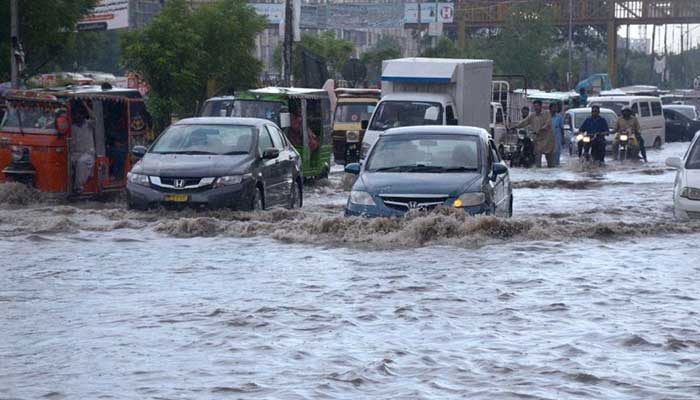DMCs absolve themselves of blame as heavy rain causes deluge in West, Central districts
The floods that beset the West and Central districts on Monday proved to be much more cataclysmic than the downpour a few parts of Karachi received during the day.
Rain was reported in the Sakhi Hassan, Five Star Chowrangi, Nazimabad, Gulberg, Ayesha Manzil, Buffer Zone, Powerhouse Chowrangi, Gulshan and Gulistan-e-Jauhar localities. Nazimabad recorded the highest precipitation at 34mm.
The major reason for the devastation in the two districts was encroachment of the minor and major storm water drains in their respective localities. Interestingly, both the elected chairmen of the West and Central district municipal corporations (DMCs) belong to the Muttahida Qaumi Movement (MQM).
The Karachi Metropolitan Corporation (KMC) is responsible for 48 major storm water drains, while 500 minor drains fall under the purview of the six DMCs. But the elected councils of the KMC and DMCs always complain of a lack of funds to clean these drains.
It wasn’t until July 2 that the KMC and DMCs got around to start cleaning the city’s nullahs — after holding several news conferences against the provincial government and demanding funds.
Most of the filth taken out of the drains in the West and Central districts was already on the footpaths and roads. After it rained heavily, the sludge was strewn across the roads and then pushed back into the nullahs due to the water pressure.
Soon after it started raining on Monday, major thoroughfares such as Sher Shah Suri Road and Shahrah-e-Pakistan, and the Landi Kotal and Water Pump areas were inundated. Both tracks of Shahrah-e-Pakistan were submerged after the overflowing of the Gujjar Nullah, a natural storm water drain starting from New Karachi and ending at the Chona Depot in Haji Mureed Goth, where it falls into the Lyari River.
The drain crosses Rashid Minhas Road at Shafiq Morr and goes towards the Café Piyala Hotel and all the way to the Ziauddin Hospital and Liaquatabad before it falls into the river. In October 2018, the long-awaited Gujjar Nullah rehabilitation project kicked off again at a cost of Rs12.5 billion. The project included the shifting of 30,000 residents and the construction of 24-feet-wide service roads on both sides of the drain.
The Pakistan Peoples Party-led Sindh government and the MQM-led local government in Karachi had been keen on starting the project that dates back to 2007. But the project never really saw the light of day.
Massive traffic jams were also reported in these two districts. Hakeem Ibn-e-Sina Road towards Liaquatabad, Board Office Chowrangi, Karimabad, Shahrah-e-Noorjahan, Qalandria Chowk and Abdullah College Road were all flooded with rainwater. In the Gulbahar area of Golimar, an emergency situation emerged as seven feet of water was accumulated, trapping the residents inside their houses.
In front of the Central DMC office in Liaquatabad, the storm water drain’s contents were flowing onto the roads, completely suspending the flow of traffic. Water and filth from the drain entered Nazimabad No. 2, No. 3 and No. 4. Water at shops in the Golimar area was up to the neck.
Not a single drop of rain fell in the Federal C Area near Liaquatabad, but the locals were hit with not less than six feet of water inside their homes.
“From the FC Area all the way till Liaquatabad No. 10, the road wasn’t visible,” said a resident named Umair Yousuf, adding that all the locals were trapped and one could not enter or exit the area.
Shops were also flooded in the Hyderi locality. “It was like a flash flood,” said a resident. “The water was running very fast and its level was continuously increasing in height. It was also carrying animal excreta. And discarded plastic bags and other garbage kept getting stuck in motorbike wheels.”
In District West, water entered the houses in the Aligarh neighbourhood of Orangi Town after the area’s gutters overflowed. A mosque in Gulfamabad was flooded as well.
The Mauripur truck station was also closed for traffic. Orangi Town’s videos were circulating on social media showing volunteers of the Jamaat-e-Islami’s Al Khidmat Foundation rescuing women and children from five or six feet of water.
West DMC Chairman Izhar Ahmed Khan claimed that the videos were fake. He explained that Union Committee 18 of his district was at a slope, due to which water from the rest of the UCs entered it and caused a flood-like situation.
He said that most of the West district was an unplanned settlement based on the banks of rivers, which caused trouble during such spells of heavy rain. As for Central DMC Chairman Rehan Hashmi, he claimed that the minor drains under his control were all cleared before the rain. “All the areas situated in a depression, such as Five Star Chowrangi, KDA and Kashmiri Mohalla, drowned due to continuous rain.”
He said that it didn’t even rain in Liaquatabad and the FC Area, but they received water from the Orangi Town, Surjani Town and Pahar Ganj areas through the overflowing of the Gujjar Nullah. Hashmi said the storm water drain, which was under the KMC, couldn’t take water because even the Lyari River was flooding.
Meanwhile, Ziaur Rehman, brother of Jamiat Ulema-e-Islam-Fazl chief Maulana Fazlur Rehman who was the city’s deputy commissioner for just a day, visited different parts of the city before his appointment order was withdrawn.
Power outages
Interruptions in the supply of electricity continued in different parts of the city after it rained in the Central and West districts. More than 300 feeders of K-Electric tripped because of the downpour. Localities in the South, East, Korangi and Malir districts faced power outages as well.
Areas like Malir, Shah Faisal Colony, Defence View, Akhtar Colony, Manzoor Colony, Gulistan-e-Jauhar, Gulshan-e-Iqbal, North Karachi, Nazimabad, North Nazimabad, Orangi Town, Liaquatabad, Surjani Town, PIB Colony, FC Area, FB Area, Azizabad, Buffer Zone and Scheme-33 as well as several other localities faced power outages that lasted late into the night.
“It didn’t rain in Gulistan-e-Jauhar, so we’re unable to understand why there was a power failure here lasting more than 12 hours,” said a resident named Shakoor.
He said that on Mondays they get water from the Karachi Water & Sewerage Board, but thanks to KE, the water utility couldn’t open their pumps. Residents of North Karachi also complained of not having electricity until late at night.
‘Segmented load-shedding’
KE said in its press statement that no unscheduled load-shedding is being carried out in any part of the city. It said that segmented load-shedding (SLS), which is in line with the National Power Policy 2013 to address the issue of pervasive power theft and load-management on account of power shortfall, follows a schedule that is duly notified to registered customers via SMS and is also available on the company’s website.
The utility said SLS is based on the theft profile of areas and is determined by the aggregate technical & commercial losses in any area. It said that due to its efforts of theft reduction, today over 75 per cent of the city is exempt from scheduled load-shedding, while load-shedding hours in the remaining areas vary with the degree of power theft.
KE said that even in very high loss areas, where losses extend to over 45 per cent, it supplies power up to 15 to 16 hours despite incurring losses, and load-shedding does not exceed 7.5 to 8.5 hours.
The company said that it conducts a periodic review to evaluate the loss of each area, and profiles it as high or low loss respectively. It said that to counter power theft, some 9,000 pole-mounted transformers have been converted to aerial bundled cables, and regular drives to remove Kundas (illegal connections) are also carried out.
The utility said that this year alone, close to 200,000 kilograms of illegal wires have been removed from electricity infrastructure in different areas, including Malir, Landhi, Korangi, Orangi, Baldia and Lyari.
It said that these efforts to address the societal menace of power theft supplemented by community engagement have been successful in shifting areas such as Altaf Town and Gazdarabad (Ranchore Line) from high loss to low loss, and resulted in reduction in transmission & distribution losses from 36 per cent in 2009 to 19.7 per cent in 2020.
KE said that while load-shedding is routinely carried out in areas with pervasive power theft and is independent of power supply, load-management is necessitated in unavoidable circumstances when the gap between power supply and demand widens for a brief duration.
It said that while circumstances outside its control, such as delayed regulatory and governmental approvals for power projects, inconsistent fuel quantities, low gas pressure and constrained supplies from various independent power producers have led to the current difficult position it is in, the company remains committed to serving its customers.
KE said that at the same time it is moving forward with an ambitious investment plan that will see $2 billion spent across the power value chain over the next three years, including a 900MW RLNG-fired power plant as well as downstream transmission and distribution upgrades.
It said that in order to evacuate additional power from the national grid on a priority basis, KE will also be investing in interconnection infrastructure, and has already sought the necessary regulatory and governmental approvals.
-
 Damson Idris, Lori Harvey Add Feul To Patch Up Rumors With PDA: Watch
Damson Idris, Lori Harvey Add Feul To Patch Up Rumors With PDA: Watch -
 Jealous Clash Over Boyfriend At Texas Gym Ends In Arrest
Jealous Clash Over Boyfriend At Texas Gym Ends In Arrest -
 Colleen Hoover Shares Major Update On Her Cancer Battle: 'Huge And Scary'
Colleen Hoover Shares Major Update On Her Cancer Battle: 'Huge And Scary' -
 Trump Targets Microsoft Over AI Electricity Costs
Trump Targets Microsoft Over AI Electricity Costs -
 ‘Making Star Trek Real’: Elon Musk Reveals Futuristic Vision For SpaceX
‘Making Star Trek Real’: Elon Musk Reveals Futuristic Vision For SpaceX -
 William Feels Frustrated As Tighter Security Makes Lives Of Windsor Residents Harder
William Feels Frustrated As Tighter Security Makes Lives Of Windsor Residents Harder -
 Meta Compute: Zuckerberg's Gigawatt-scale Bet To Dominate The AI Era
Meta Compute: Zuckerberg's Gigawatt-scale Bet To Dominate The AI Era -
 King Charles Big Plans For Meghan Markle, Prince Harry Revealed
King Charles Big Plans For Meghan Markle, Prince Harry Revealed -
 'Stranger Things' Creators Duffer Brothers Face Shocking Accusations
'Stranger Things' Creators Duffer Brothers Face Shocking Accusations -
 Google Ends Dark Web Personal Data Leak Alerts From January 15
Google Ends Dark Web Personal Data Leak Alerts From January 15 -
 Elon Musk’s X In Legal Trouble: List Of Countries Taking Action Over Grok AI Deepfakes
Elon Musk’s X In Legal Trouble: List Of Countries Taking Action Over Grok AI Deepfakes -
 Prince William Takes Shocking New Stance On Prince Harry's Fight For Security
Prince William Takes Shocking New Stance On Prince Harry's Fight For Security -
 Kate Middleton Sends Powerful Message To Meghan Markle, Prince Harry
Kate Middleton Sends Powerful Message To Meghan Markle, Prince Harry -
 BBC Seeks Dismissal Of Trump's $10bn Defamation Lawsuit
BBC Seeks Dismissal Of Trump's $10bn Defamation Lawsuit -
 Ex-UK Envoy Mandelson Issues ‘unequivocal’ Apology To Epstein's Victims
Ex-UK Envoy Mandelson Issues ‘unequivocal’ Apology To Epstein's Victims -
 Kate Middleton Accused Of Being ‘silent Assassin’ Pitting William Against Andrew
Kate Middleton Accused Of Being ‘silent Assassin’ Pitting William Against Andrew




